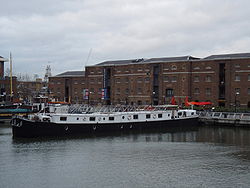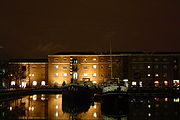
Museum in Docklands
Encyclopedia
The Museum of London Docklands (formerly known as Museum in Docklands) is a museum on the Isle of Dogs
, east London that tells the history of London's River Thames
and Docklands. The museum is part of the Museum of London Group
which is jointly funded by the City of London Corporation and the Greater London Authority
.
The museum opened in 2003 in a group of grade I listed early 19th century Georgian
"low" sugar warehouses built in 1802 on the side of West India Docks
on the Isle of Dogs, a short walk from the Canary Wharf
development.
The nucleus of the collection is the museum and archives of the Port of London Authority
. These became part of the port and river collections of the Museum of London
in 1976, but largely remained in storage until the new museum was opened.
The museum uses the latest presentational techniques including videos presented by Tony Robinson
, known for his involvement with Time Team
. There is a large collection of historical artefacts, models, and pictures. It is a substantial museum with 12 galleries and a children's gallery (Mudlarks), arranged over two of its floors. Visitors are directed through the displays in chronological order. The periods covered range from the first port of London in Roman
times to the closure of the central London docks in the 1970s and the subsequent transformation of the area with new commercial and residential developments.
Museum of London Docklands includes a lecture theatre and meeting rooms and there are often talks and events connected with the docks. Several dock workers who worked on the docks in the sixties take part in these events, including one from the Pentonville Five
. There is also a reading room and the Sainsburys Study Centre where the public are welcome to consult the archives; a restaurant and shop.
Entry to the Museum is now free.


The museum recommends visitors to start their visit from floor 3
Isle of Dogs
The Isle of Dogs is a former island in the East End of London that is bounded on three sides by one of the largest meanders in the River Thames.-Etymology:...
, east London that tells the history of London's River Thames
River Thames
The River Thames flows through southern England. It is the longest river entirely in England and the second longest in the United Kingdom. While it is best known because its lower reaches flow through central London, the river flows alongside several other towns and cities, including Oxford,...
and Docklands. The museum is part of the Museum of London Group
Museum of London Group
The Museum of London Group is a public body based in the City of London. Since 1 April 2008 it has been funded jointly by the Greater London Authority and the City of London Corporation...
which is jointly funded by the City of London Corporation and the Greater London Authority
Greater London Authority
The Greater London Authority is the top-tier administrative body for Greater London, England. It consists of a directly elected executive Mayor of London, currently Boris Johnson, and an elected 25-member London Assembly with scrutiny powers...
.
The museum opened in 2003 in a group of grade I listed early 19th century Georgian
Georgian architecture
Georgian architecture is the name given in most English-speaking countries to the set of architectural styles current between 1720 and 1840. It is eponymous for the first four British monarchs of the House of Hanover—George I of Great Britain, George II of Great Britain, George III of the United...
"low" sugar warehouses built in 1802 on the side of West India Docks
West India Docks
The West India Docks are a series of three docks on the Isle of Dogs in London, the first of which opened in 1802. The docks closed to commercial traffic in 1980 and the Canary Wharf development was built on the site.-History:...
on the Isle of Dogs, a short walk from the Canary Wharf
Canary Wharf
Canary Wharf is a major business district located in London, United Kingdom. It is one of London's two main financial centres, alongside the traditional City of London, and contains many of the UK's tallest buildings, including the second-tallest , One Canada Square...
development.
The nucleus of the collection is the museum and archives of the Port of London Authority
Port of London Authority
The Port of London Authority is a self-funding public trust established in 1908 by the Port of London Act to govern the Port of London. Its responsibility extends over the Tideway of the River Thames and the authority is responsible for the public right of navigation and for conservancy of the...
. These became part of the port and river collections of the Museum of London
Museum of London
The Museum of London documents the history of London from the Prehistoric to the present day. The museum is located close to the Barbican Centre, as part of the striking Barbican complex of buildings created in the 1960s and 70s as an innovative approach to re-development within a bomb damaged...
in 1976, but largely remained in storage until the new museum was opened.
The museum uses the latest presentational techniques including videos presented by Tony Robinson
Tony Robinson
Tony Robinson is an English actor, comedian, author, broadcaster and political campaigner. He is best known for playing Baldrick in the BBC television series Blackadder, and for hosting Channel 4 programmes such as Time Team and The Worst Jobs in History. Robinson is a member of the Labour Party...
, known for his involvement with Time Team
Time Team
Time Team is a British television series which has been aired on Channel 4 since 1994. Created by television producer Tim Taylor and presented by actor Tony Robinson, each episode features a team of specialists carrying out an archaeological dig over a period of three days, with Robinson explaining...
. There is a large collection of historical artefacts, models, and pictures. It is a substantial museum with 12 galleries and a children's gallery (Mudlarks), arranged over two of its floors. Visitors are directed through the displays in chronological order. The periods covered range from the first port of London in Roman
Roman Britain
Roman Britain was the part of the island of Great Britain controlled by the Roman Empire from AD 43 until ca. AD 410.The Romans referred to the imperial province as Britannia, which eventually comprised all of the island of Great Britain south of the fluid frontier with Caledonia...
times to the closure of the central London docks in the 1970s and the subsequent transformation of the area with new commercial and residential developments.
Museum of London Docklands includes a lecture theatre and meeting rooms and there are often talks and events connected with the docks. Several dock workers who worked on the docks in the sixties take part in these events, including one from the Pentonville Five
Pentonville Five
The Pentonville Five were five shop stewards jailed in July 1972 by the National Industrial Relations Court for refusing to obey a court order to stop picketing of a container depot in East London....
. There is also a reading room and the Sainsburys Study Centre where the public are welcome to consult the archives; a restaurant and shop.
Entry to the Museum is now free.


Floor directory
| Floor 3 | Floor 2 | Floor 1 Access from floor 2 only |
Ground floor | Basement floor |
|---|---|---|---|---|
| Wilberforce Theatre Quayside Room Function Suite Thames Highway AD 43-1600 Trade Expansion 1600-1800 Legal Quay 1790s London Sugar & Slavery 1600 onwards |
City and River 1800-1840 Sailortown 1840-1850 First Port of Empire 1840-1880 Warehouse of the World 1880-1939 Docklands at War 1938-1945 New Port, New City 1945 onwards |
Thames Gallery 1930-1940 Sainsbury Study Centre |
Entrance Mudlarks For the Under 12s Special Exhibitions 1802 Café 1802 Bar Lounge & Dining |
Schools and Coach Parties Entrance Lee Boo Room Refectory and Weekend Picnic Room Jack Petchey Classroom Lansbury Classroom Pocahontas Classroom |
The museum recommends visitors to start their visit from floor 3
Transport connections
| Service | Station/Stop | Lines/Routes served | Distance from Museum of London Docklands |
|---|---|---|---|
| London Buses | Westferry Station | 135 London Buses route 135 London Buses route 135 is a Transport for London contracted bus route in London, United Kingdom. The service is currently contracted to Arriva London for London Buses.-History:Route 135 began operation on 24 May 2008... , 277 London Buses route 277 London Buses route 277 is a Transport for London contracted bus route in London, United Kingdom. The service is currently contracted to Stagecoach London.-History:... , D3, D7 |
|
| London Underground | Canary Wharf Canary Wharf tube station Canary Wharf tube station is a London Underground station on the Jubilee Line, between and . It is in Travelcard Zone 2 and was opened by Ken Livingstone setting an escalator in motion on 17 September 1999 as part of the Jubilee Line Extension. It is maintained by Tube Lines... |
0.5 mile walk | |
| Docklands Light Railway | West India Quay West India Quay DLR station West India Quay DLR station is a station on the Docklands Light Railway in London, England. It is situated at the point where the line from Lewisham splits into branches to Tower Gateway/Bank and Stratford. The next stations on each line are Canary Wharf DLR station , Westferry and Poplar DLR... |
2 minute/400 mteres walk | |
| London River Services |
Canary Wharf Pier Canary Wharf Pier The Canary Wharf Pier is a London River Services pier on the River Thames in London, UK. It is located to the west of the Canary Wharf district, close to Narrow Street, Limehouse.... |
Commuter Service Rotherhithe to Canary Wharf Service Thames Clipper Thames Clipper is a water-bus service operating in London on the River Thames. The company offers commuter services between eastern and central London, as well as tourist services under licence from London River Services. At present they transport around 7,500 passengers daily.-Company:Sean Collins... |
0.3 mile walk |
See also
- Museum of London ArchaeologyMuseum of London Archaeology ServiceMuseum of London Archaeology is a Registered Archaeological Organisation with the Institute of Field Archaeologists and is a self-financing part of the Museum of London Group, providing a wide range of professional archaeological services to clients in London, SE England, the UK and...
- Island History TrustIsland History TrustThe Island History Trust is a local history institution based on the Isle of Dogs in east London, England. The Trust was created by volunteers, who started to collect photographs of local life in 1981. At that time the docks and nearly all the local factories had closed, and the transformation of...

